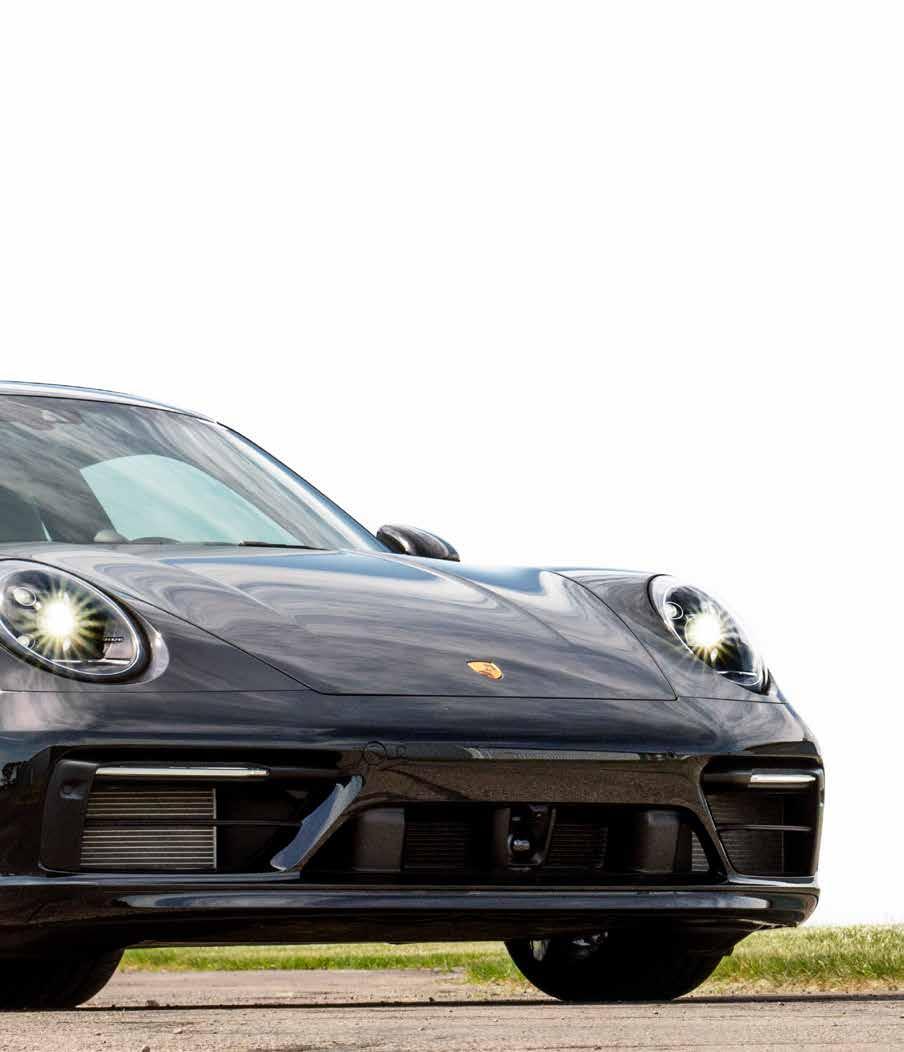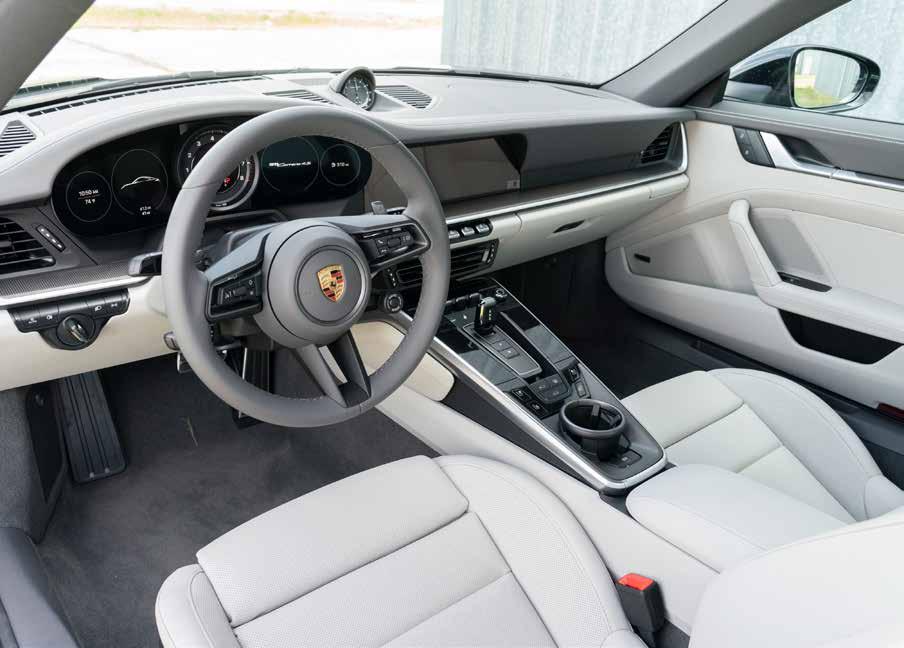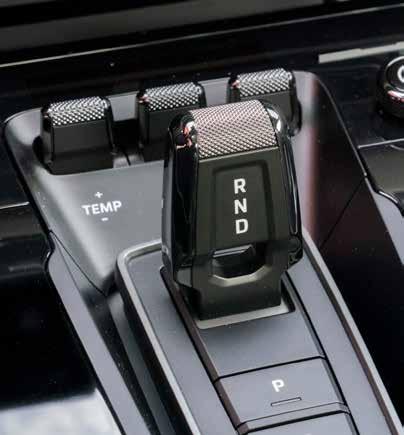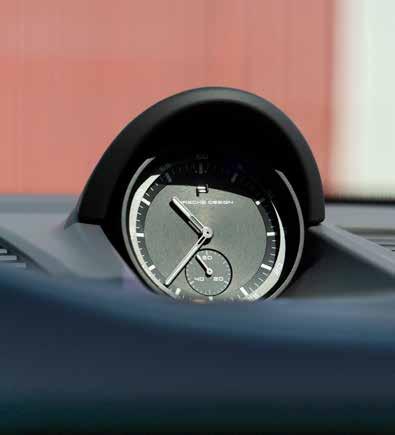
5 minute read
The 911 Keeps its Focus and Gets Better With Age.
Seventy-Five years ago on June 8, the 356 No. 1 Roadster became the first automobile bearing the Porsche name to receive certification for the road, and a sports car brand was born. Ferry Porsche’s dream sports car was a reality and for the next 15 years the 356 captured the hearts of enthusiast drivers and racers.
By the early 1960s, it was time for the next generation Porsche, and the 911 was introduced in 1963 as the successor to the 356. With a six-cylinder engine hanging out over the rear axle, a slant-nosed body with wide hips, and a sloping tail, the 911’s iconic shape is recognized the world over.
Advertisement
The first 911, powered by a 130-horsepower, 2.0-liter six-cylinder, air-cooled engine, was the progenitor of a model line that flourishes still today. In fact, the 911 has come to define Porsche as a company even though its portfolio now includes the mid-engine 718, Panamera four-door sedans, two SUVs, and the all-electric Taycan.

Of course, the 911 has grown, evolved, and transformed for 60 years.
The lineage includes the 911 S (1967), the 911 Turbo (1976 in the U.S.), the first 911 Cabriolet (1983), and the first all-wheel-drive 911 Carrera 4 (1990). The first water-cooled 911 debuted in 1999. Today, there are 26 different 911 coupe and convertible models, ranging in price from $114,400 for the Carrera to $243,200 for the Turbo S Cabriolet. In addition, there are two GT3 models, a GT3 RS, a Sport Classic model, and a Dakar off-road-capable version. I drove a Carrera 4S that had a base price of $130,300 and a sticker price of $171,740.

Modernization of the 911 was inevitable and necessary. The flatsix boxer engine is now water cooled instead of air cooled, and the suspension has been designed to tame the original car’s tendency to be tail happy if pushed too hard into a corner. The overall size is now more accommodating to passengers as well as technology that includes turbocharged engines and all-wheel drive. Today’s eighth-generation 911 is considerably larger physically, and the power output of its 3.0-liter twin-turbo engine, 443 horsepower in the current Carrera S, makes the original 2.0-liter engine look anemic by comparison. More powerful variants go all the way up to the 911 Turbo with 572 horsepower.
The 911 Carrera S gets to 60 miles per hour in 3.5 seconds, and the 911 Carrera 4S with all-wheel drive takes 3.4 seconds. The optional Sport Chrono Package reduces this time by a further 0.2 seconds to 3.3 seconds for the 911 Carrera S and 3.2 seconds for the 911 Carrera 4S.
The newest 911 combines classic styling with state-of-the-art technology features and enhancements. The chassis has wider track widths and features 19-inch wheels in front and 20-inch wheels in back, the first time Porsche has put different diameter wheels on the 911.
To refresh my experience with the 911, I slipped behind the wheel of a black Carrera 4S fresh from the showroom for a few hours of driving. It’s been several years since I last drove a 911, and the first thing I noticed was how civilized and comfortable it is. The twin-turbo engine screams with joy if you mash the throttle but it is also content to trundle around on city streets without complaint.
Roadholding is paramount, yet the ride is not harsh. With a knob on the steering wheel, the driver can select Normal, Sport, Sport Plus, and Wet drive settings that transform the car from kitten to tiger.
Porsche says this 911 is the first car in the world to feature an innovative system for recognizing significant amounts of water on the road. The Wet driving mode automatically sets the car’s stability control and anti-lock brake systems for optimal operation in fine-tune the aerodynamics and arrive at a chassis that has a curb weight of just over 3,300 pounds. wet conditions when these are detected. It also gives the driver the option of tailoring the vehicle’s drivetrain further to these adverse conditions at the touch of a button. The warning and brake assist system – also fitted as standard – detects the risk of collisions with vehicles, pedestrians, and cyclists. It also initiates a warning or emergency braking if necessary. car, with functionality and visibility paramount.” The central tunnel is clad with carbon fiber and only carries the switches that are necessary. steering wheel also work with the infotainment system.

The carbon-fiber chassis makes use of underbody aerodynamics that help keep the top of the car sleek and sensual with rounded contours that echo classic design. The nose contains a grille that is recognizably Maserati complete with the Trident emblem.


Maserati and Sabelt collaborated on the design and creation of the MC20 seats. A composite structural shell, equipped with power adjustments and lumbar system, represents the essence of the MC20 project: sportiveness at a high quality and performance level.
The cabin is snug but not confining, and it can accommodate various size drivers. The tiny rear seat is best used for briefcases, tiny tots, or a pet. The bucket seats have a wide range of adjustability, as does the steering wheel. The cabin has two touchscreen panels, one for navigation, audio and Apple CarPlay (or wired Android Auto); the other, on the console, contains touch switches for controlling heating/cooling, seat heating, and suspension adjustments. Voice commands and buttons on the
Upward-opening “butterfly” doors pivot forward to so the driver and passenger can get into the cabin with a minimum of interference. The cabin is understated, and driver focused. The interior shapes are simple, with few sharp corners and the upholstery and interior materials are black to prevent reflections on the steep sloping windscreen. Plus, black lends a feeling of understated elegance. There are two LCD screens in the instrument panel, one in front of the driver for gauges and one in the center above the console. Maserati emphasizes that “everything is laid out just like the cockpit of a racing
The MC20’s Sonus faber audio embodies the translation of its name, “handmade sound” that illustrates how both brands desire to pair innovative technologies and skillful craftsmanship.
A new eight-speed PDK dual-clutch transmission takes the place of the previous seven-speed. All gears have new ratios: first through seventh gears are now shorter, while eighth gear is longer than the previous seventh gear. Porsche indicates this makes it possible to use a longer final-drive ratio, which lowers engine speeds in the upper gears further. The wider spread of gears makes it possible to reduce fuel consumption. I noticed an average of 22 miles per gallon in mixed freeway and city driving.
Porsche steering is always direct and the brakes are outstanding. After 60 years of development, the 911 bridges the original design concept with current technology and performance in a way that signals driver engagement will always be a priority for this model.
Committing the MC20 to production is a bold statement from Maserati about how it sees itself, both today and in the future when an all-electric version will be available. That forward vision is necessary for a company that has such a long and storied history.
ABOUT THE AUTHOR / PHOTOGRAPHER
ABOUT THE AUTHOR / PHOTOGRAPHER
Tom Strongman has a degree in photojournalism from the University of Missouri and was formerly the director of photography and then the automotive editor of The Kansas City Star. Tom, a member of the Missouri Press Association Photojournalism Hall of Fame, has written about and photographed cars for more than three decades.
Tom Strongman has a degree in photojournalism from the University of Missouri and was formerly the director of photography and then the automotive editor of The Kansas City Star. Tom, a member of the Missouri Press Association Photojournalism Hall of Fame, has written about and photographed cars for more than three decades.










